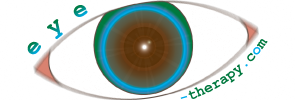
 | There are two kinds of people in this world - those who like to be surprised and those who like to wait for what they know is going to happen. |
Peripheral Vision
Peripheral vision is the vision outside of the detailed central macular vision. Peripheral vision is sometimes broken into rings, like a target. In the center is the detailed macular vision where the fovea is. The near-peripheral, or "paracentral" vision, is just around the center and is surrounded by the mid-peripheral vision. The far peripheral vision is at the edges of the field of view. Colors and Shapes are Hard to DetectPeripheral vision is noted for being course, especially at detecting colors and distinguishing shapes. Receptor cells on the retina are denser at the center and least dense at the edges. In addition, cone cells which detect colors are concentrated at the center of the retina, while rod cells which can not detect color are concentrated near the periphery. Better in the DarkPeripheral vision is better in the dark because cone cells are not very useful when there is little light or color. It is also superb at detecting motion. Rod cells, concentrated at the edge, detect motion. Diseases Affecting Peripheral VisionPeripheral vision is most commonly affected by Glaucoma, branch retinal artery or vein occlusion, ischemic optic neuropathy and strokes or transient migraines. It is quite common to lose some peripheral vision without even realizing it. Testing your Peripheral VisionLook straight ahead at a point on the wall, hold your hand out to the side and wiggle your thumb. Slowly swing each hand in, noticing when you can first detect the movement of your thumb. Your vision is normal if you can see almost straight to the side (90 degrees away) and just past your nose (30 to 45 degrees) on each side. Perimetry TestsPerimetry tests measure your peripheral vision. These are the automated tests you get when you visit the eye doctor. Read more about peripheral vision
|
|||||||
Home
Facts and Fiction
Resolution
Color and Eyesight
Benhams Disk
Chromatic Adaptation
Chromostereopsis
Color Blindness
Color Discrimination
Color Sensitivity
Gender Differences
Metamerism
Trichromatic Theory
Eye Color
Peripheral Vision
Blind Spot
Night Vision
Aging Effects
Hold Time Timing
|
   |
||||||
| Eye-Therapy.com |
DISCLAIMER: The information published here is for entertainment purposes only and is in no way intended to dispense medical opinion or advice or to be a substitute for professional medical care, be it advice, diagnosis or treatment, by a medical practitioner. If you feel ill or if you have a medical issue, you should consult a health care professional.
Site Map |
Terms of Use |
Privacy & Security |
Contact Us |
Purchase Agreement |
Send Feedback |